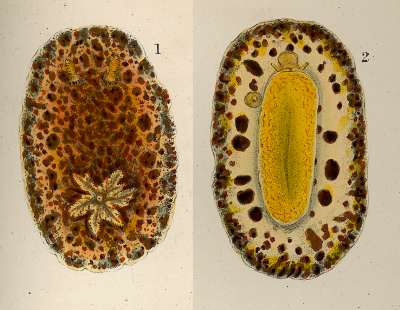
Platydoris ellioti
(Alder & Hancock, 1864)
Order: NUDIBRANCHIA
Suborder: DORIDINA
Superfamily: EUDORIDOIDEA
Family: Dorididae
DISTRIBUTION
Tropical Indo-West Pacific
PHOTO
Plate 28, figs 1, 2 - from Alder & Hancock, (1864).
The animal is large and flat with a wide mantle and narrow body. The rhinophore sheaths are raised and the gill sheath is raised and developed into 6 lobes. The dorsum is translucent brown with small brownish blotches scattered all over. Around the mantle edge there is a band of greenish grey blotches. The underside of the mantle and the foot is yellow or yellow-orange. The underside of the mantle has a ring of relatively large rounded brown spots, and around the mantle margin the brwnish colour from the dorsal surface shows through. There can be translucent brown speckling on the sole of the foot. Grows to at least 11 cm in length.
Note: this species is named after Walter Elliot a colonial naturalist in India, not the more famous Charles Eliot, so the species name is spelt ell ioti.
-
Alder, J. and Hancock, A. (1864) Notice of a collection of nudibranchiate mollusca made in India by Walter Elliot Esq., with descriptions of several new genera and species. Transactions of the Zoological Society of London, 5: 113-147.
-
K.M. Dorgan, A. Valdes and T.M. Gosliner. (2002) Phylogenetic systematics of the genus Platydoris (Mollusca, Nudibranchia, Doridoidea) with descriptions of six new species. Zoologica Scripta, 31: 271-319.
Rudman, W.B., 2005 (September 14) Platydoris ellioti (Alder & Hancock, 1864) . [In] Sea Slug Forum. Australian Museum, Sydney. Available from http://www.seaslugforum.net/find/platelli
Related messages
Platydoris ellioti from Tanzania
May 21, 2009
From: Bill Rudman
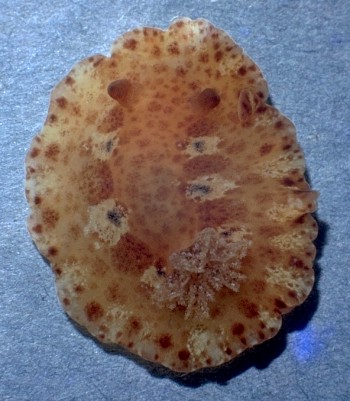
To complement my message on Platydoris pulchra from Tanzania [#22489] , here is a photo of Platydoris ellioti from Dar es Salaam.
Locality: Under sewer pipe, Ocean Road Beach, entrance to harbour, Dar es Salaam, Tanzania. 16 September 1974. 1 specimen approx 50 mm long alive. Photo: Bill Rudman.
The underside was a bright orange yellow with a row of dark brown spots forming a ring around the mantle skirt about midway between the mantle edge and the body. There were also son smaller brown spots on the side of the foot.
Bill Rudman
Rudman, W.B., 2009 (May 21) Platydoris ellioti from Tanzania. [Message in] Sea Slug Forum. Australian Museum, Sydney. Available from http://www.seaslugforum.net/find/22490Platydoris ellioti from Thailand
July 3, 2008
From: Lawrence Neal
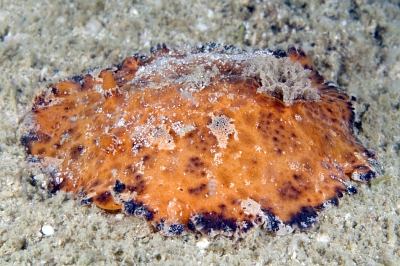
Dear Bill,
Perhaps you could help with ID for this slug. It looks to me like Platydoris pulchra but the photo was taken in the Gulf of Thailand, South China Sea which is a rather major range extension from the previous sightings. I don't know if the shot of the animal's foot will help with ID or not.
Locality: Koh Sark, Pattaya, 6 metres, Thailand, Gulf of Thailand, South China Sea, 7 June 2008, Sheltered bay, mixed sand and sediment. Length: 60 mm. Photographer: Lawrence Neal.
All the best,
Lawrence
lorenzo_n@yahoo.com
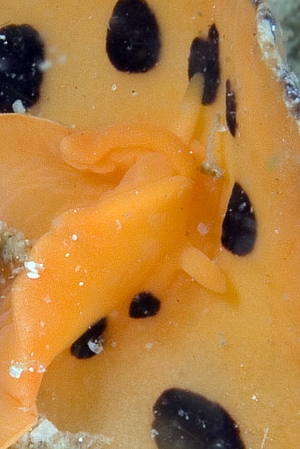
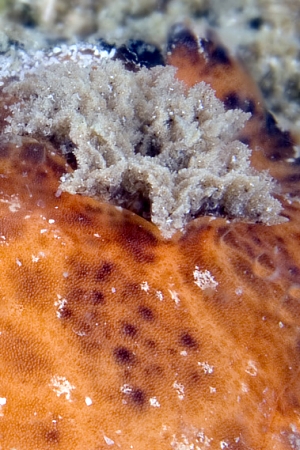
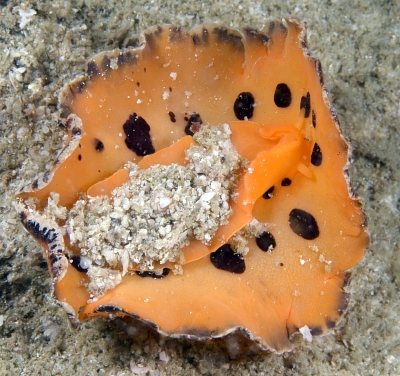
Dear Lawrence,
I am glad you included a photo of the underside. It certainly looks like P. pulchra from the photos of its upper surface, but the large brown spots on the underside of the mantle clearly identify it as Platydoris ellioti. In some dorids, the colour of the underside can be very valuable in species identification, but unfortunately it is not often photographed. I have included two close-up photos. One shows the gills. The other shows the head and oral tentacles which are usually not seen in photos of dorids with a wide mantle skirt.
Best wishes,
Bill Rudman
Platydoris ellioti from Lembeh?
June 21, 2007
From: Francis & Pirjo Pellet
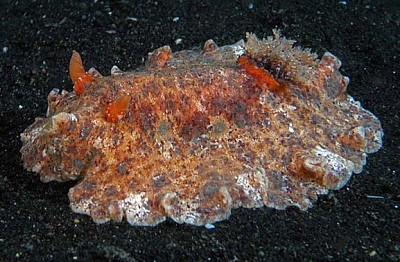
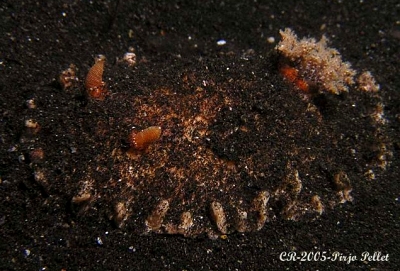
Hi Bill,
Attached some shots of a Platydoris from Lembeh Strait.
The second photo was taken in situ; the mantle was totally covered by black sand and you could only see the gills and the rhinophores. We think this could be Platydoris ellioti?
Locality: Teluk Kambahu, 7m, Indonesia, Indo Pacific, 10 october 2005, Sand. Length: 60 mm. Photographer: Francis and Pirjo Pellet.
Please, can you confirm the ID.
Best wishes
Francis & Pirjo
pirjo.pellet@free.fr
Pellet, F. & P., 2007 (Jun 21) Platydoris ellioti from Lembeh?. [Message in] Sea Slug Forum. Australian Museum, Sydney. Available from http://www.seaslugforum.net/find/19475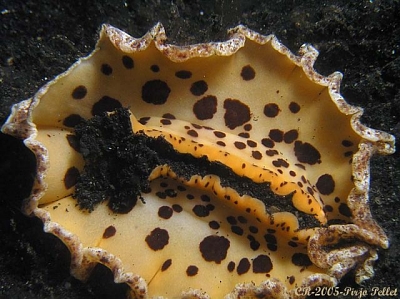
Dear Francis & Pirjo,
Yes I would say this is P. ellioti. It looks as though a photo of the underside is going to be almost compulsory for these animals as it seems to be a most useful distinguishing feature. The yellow background colour and dark brown spots on the sides of the foot and the underside of the mantle seem to be a good indicator of this species.
Best wishes,
Bill Rudman
Platydoris ellioti from Philippines
September 17, 2005
From: Jeff Rosenfeld
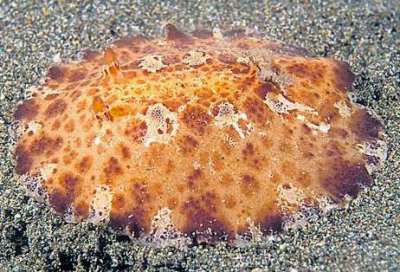
Hi Bill,
Here's a shot of Platydoris speciosa taken in Anilao, Luzon Island, Philippines in April, 2004. I noticed you don't currently have a page for this species.
Locality: Anilao, Depth: 30 ft. Length: 15 cm. April, 2004. Sand and pebbles
Photographer: Jeff Rosenfeld
Thanks,
Jeff
http://www.vibrantsea.net
jeff@rosenfeldfamily.net
Rosenfeld, Jeff, 2005 (Sep 17) Platydoris ellioti from Philippines. [Message in] Sea Slug Forum. Australian Museum, Sydney. Available from http://www.seaslugforum.net/find/14682Dear Jeff,
I had been planning a page on Platydoris speciosa, but as a recent review shows (Dorgan, Valdes & Gosliner, 2002) the earliest name for this species appears to be Platydoris ellioti. I don't suppose you have a shot somewhere of the underside? The colour pattern on the underside is quite distinctive in many of these species but understandably, it is seldom photographed.
Best wishes,
Bill Rudman
Platydoris ellioti - North Western Australia
September 15, 2005
From: Corey Whisson
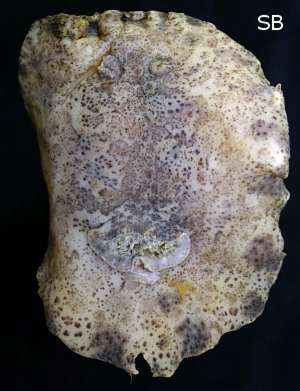
Dear Bill,
We recently collected several specimens from trawls at Exmouth Gulf and Shark Bay, north-western Australia. I am having trouble identifying them - mainly due to their size. Unfortunately these are preserved photos.
Locality: Exmouth Gulf (11 m, 4 August 2004), and Shark Bay, (20 m, 25 September 2003), Western Australia, Australia. Lengths: Exmouth (90 mm), Shark Bay (110 mm). Trawled. Photographer: Corey Whisson
Both animals have characteristic chocolate brown blotches on their ventral side. These appear to form two circles, with the inner circle nearest the foot having smaller sized blotches. Coupled with this, is the presence of brown speckles on the sides of the foot of the smaller [EG] (90 mm) Exmouth Gulf animal. The larger [SB ] (110 mm) Shark Bay animal has a white foot, no brown speckles. On both animals there seems to be paired black blotches in the middle of the mantle on the dorsal side.
With the literature I have read, it might be Discodoris lilacina but the sizes are much larger than the literature. Platydoris scabra has been floated?? Can you help with this?
Thank you
Corey
corey.whisson@museum.wa.gov.au
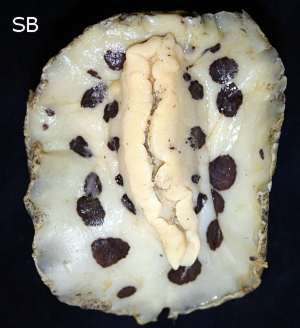
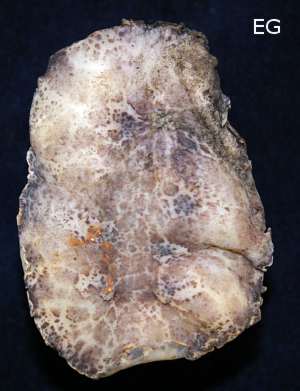
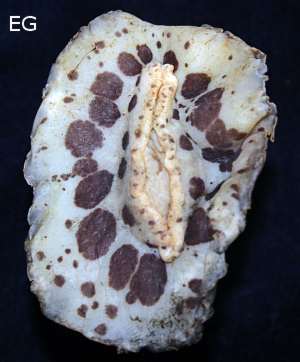
Dear Corey,
I am pretty sure this is Platydoris ellioti. This genus was recently reviewed (Dorgan, Valdes & Gosliner, 2002) and although the original description of this species lacked much anatomical detail, the external features and colour pattern seem fairly constant. In life your animal the underside of the mantle, and the foot, would have had a yellow or orange yellow background colour.
Best wishes,
Bill Rudman
